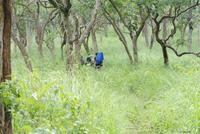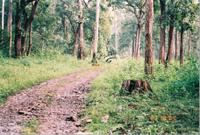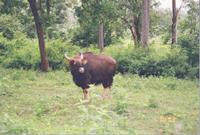Giritale Lake, Srilanka
 In Srilanka, we din’t want to move between places like nomads. But, we wanted to visit all the places worth visiting in the region.
In Srilanka, we din’t want to move between places like nomads. But, we wanted to visit all the places worth visiting in the region.Anuradhapura, Polonnaruwa, Sigiriya and Dambull were on the list of places we wanted to visit, before proceeding to Kandy. We wanted to choose a place which is close to all these places, so that we could visit these places as a single day excursion. It is possible to visit each of these places per day, as all these places are in the northern part of Srilanka.
We had 2 possible places to choose from. We could stay at Habarana or Giritale. Habarana is basically a town which is close to all the 4 historical sites I mentioned. It does not have any significance by itself.
But, Giritale has a large water tank created artificially by the ancient rulers to collect water, to be used later for irrigation. Giritale tank is surrounded by forest area which is marked as National forests in Srilanka. The famous Minneria National Park and Kaudulla National Park are here in this zone.
Therefore, staying in Giritale was the right thing to do. I love natural surroundings and am a sucker for ecologically beautiful places. The prospect of staying in a hotel with rooms and restaurants overlooking a large lake, with elephants and birds to look out for, helped us decide.
Giratale was going to be for center point for the trip. A search on google gave a huge list of hotels in this area. Lotus Pond, Deer Park hotel and Giritale hotel were some of the hotels which google threw up. Giritale hotel fit out budget. The images on their website really excited us.
After the spicy thali meals at Habarana, we reached Hotel Giritale by the evening. Mathow himself was very excited about taking us there, and kept telling us that the view from this hotel is fabulous.
When we got there, checked into our rooms and looked around the facilities we realized that Mathow was right, and that we had made the right decision.
All the rooms in Hotel Giritale overlook the lake, the bar, the restaurant and the resting area, all of them are designed to face the lake. The lake is huge, with large green islands in the middle, and the surrounded by low folding hillocks. The lake is surrounded by the Minneriya reserve area. The hotel had a telescope through which you could look for elephants and other animals. From the hotel we could see, the fishermen going in the lake for fishing. The sunset view from the hotel lobby and the swimming pool deck are stunning.
Giritale lake was built in the 12th century to collect rain water.
Srilanka is the first country in the world to set up a flora and fauna reserve park in Mihintale in 3rd Century BC. Now, over 12 % of land demarcated a reserve forest. These forests are home to elephants, leapords and a wide varieties of animals, birds and plants. 5 of the world endangered varieties of turtles are supposed to live on the Srilankan coasts.
The popular national parks are Minneriya, Kaudulla, Yala, Lahugala, Uda Walawe, Bundala and the Sinharaja National parks. There are in all 50 reserve forests. The one that attracts the maximum number of tourists is the Pinnewala elephant orphanage. It houses about 60 orphaned elephants and calves. Pinnewala is 72 kms from Colombo.
About the hotel, Giritale hotel is designed in ethnic style with ethnic style furniture in the lobby, reception and the waiting area. There is a lotus pond. The hotel is full of brass and terracotta and granite figurines of ancient kings and queens. The lighting is beautiful and the staff are very kind and pleasant. The hotel has rooms facing the lake as indicated earlier, some of them have balconies as well. Never the less, all rooms have access to the lawns below. The hotel also has a mutli cuisine restaurant, a bar, swimming pool and a Ayurvedic centre.
The hotel is full of monkeys that come from the nearly jungles. We had to keep our balcony doors closed at all the time because of this.
We spend the next 4 days at this place. Our daily routine was always same. We would wake up at 6.30 am, get ready, have out breakfast and leave for the destination of the day. Polonnaruwa is about 1 hr from Giritale, Anuradhapura was the farthest – 90 kms away, took 1 and half hour to reach, Sigiriya was 1 hr away. So, all the planned places were easily accessible. We could also go to Minneriya or Kaudulla for a wild life safari. One can also go to one of the nearby village to observe the life there. We had done enough safaris in India, and din’t want to explore that bit.
I was told that Anuradhapura and Polonnaruwa need about 2 to 3 days to visit each and every spot slowly. Like all tourists we had just 1 day for each place. But, Mathow was thoughtful. He planned our day very well.
We always finished our sight seeing by 2 pm, had lunch in the local hotel and got back to Giritale hotel by about 4 pm. Then, we would take a quick nap, then, freshen for cocktails in the evening.
The bar and the waiting / resting area is a huge balcony overlooking the lake. Sipping tea or a cocktail there was a pleasure. All the time that I was day, we had a good sunset drama on the first day alone. It rained in the evening, which made the place cool, but, I never got to see another sunset because of this.
The food at this hotel is fabulous. We had the best breakfast possible. The dinner was awesome and the chef ensured that we had the best dessert. I completely forgot about my diet and indulged in eating mousse, 2 to 3 helpings on a daily basis. The food and the cocktails were amazing. I would never forget it.
Day 1 - Read Negembo, Srilanka.
Day 2 - Read Dambulla Golden Temple, Srilanka




